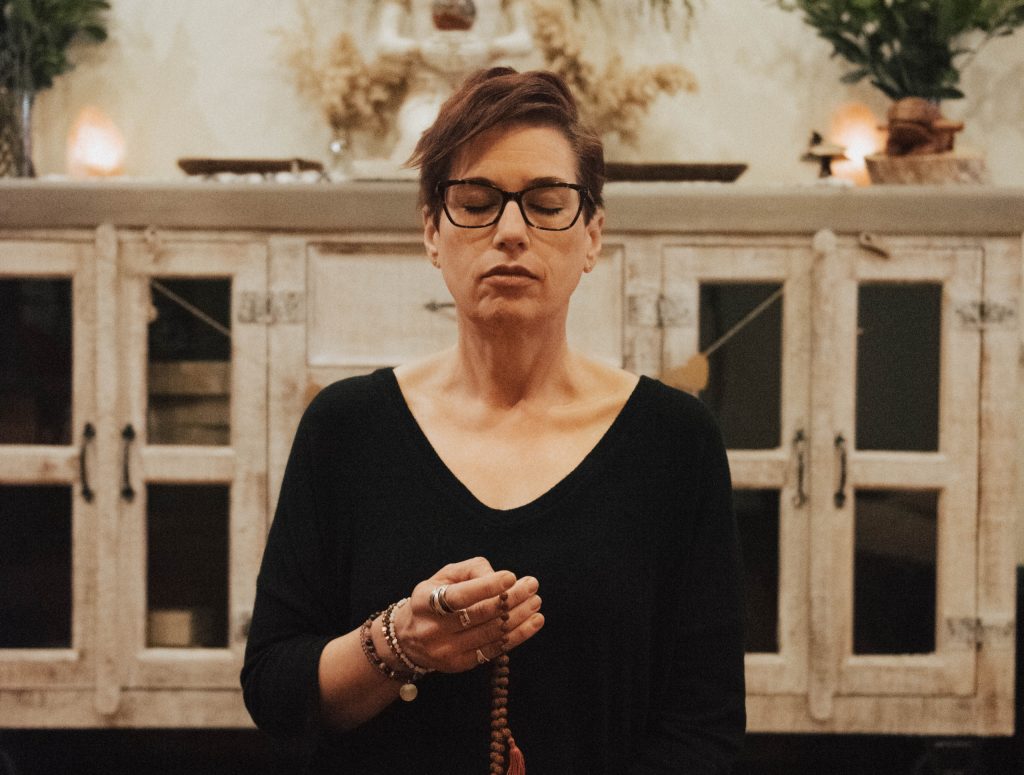Breathe Calm: A Simple Mindfulness Practice
We’ve all seen idealized images of meditation. Perhaps it’s a young woman on a deserted beach, hands in a meditation-friendly mudra, enjoying a sunset. Or maybe it’s an image like the one at the top of this post—a person with serene countenance, fingering mala beads in deep contemplation. It’s true that meditation can be peaceful. But sometimes, it’s marked by cascading thoughts and memories, raw emotions and/or physical discomfort. It’s important to remember that in mindfulness practice, the latter experience doesn’t mean you’re doing something wrong. Those thoughts, memories, emotions and discomforts are simply what is present. They are, in a very real sense, what there is to be mindful of. But when these experiences become overwhelming, mindfulness has a solution: a breath awareness practice designed to calm the body and mind.
When I teach mindfulness courses, many new meditators doubt their ability to practice. They’ll say, “Every time I sit down to meditate, my mind goes crazy. My thinking amps up more than ever.” To that, I tell them that they’re not thinking more when they meditate; they’re instead observing for the first time what’s been happening in their minds all along. I explain that mindfulness is not about stopping your thoughts. It’s about dealing with your thoughts in a skillful way.
We can be mindful of the process of thinking, instead of getting caught up in the content of our stories, memories, worries and dramas. Mindfulness of thinking is actually one of the four foundations of mindfulness. But sometimes, we need to slow the process down so that we can be with the thinking process with more equanimity. That’s where the breath awareness practice I’m about to describe can be invaluable.
Breath Awareness to the Rescue
On an 18-day retreat at Spirit Rock Meditation Center a few years ago, this breath awareness technique helped me navigate what I can only describe as a “massive memory dump.” Starting in the wee hours of the morning one night, memories began flowing, completely uncontrolled, at a pace I didn’t think possible. Life events I hadn’t thought of in decades were flashing through my consciousness nonstop, and at warp speed. None of it was traumatic, but it became exhausting after a while.
After several hours of experiencing this memory dump, I remembered a breath awareness practice that I thought might be able to slow things down a bit. It’s a very simple practice that I’d heard on an instruction CD by author/Insight Meditation teacher Joseph Goldstein. After just a few minutes of practice, the whole rapid-fire movie slowed down, and I felt a deep sense of calm.
How to Practice Calming Breath Awareness
Gather your props: a Meditation Cushion and Zabuton. If you don’t have a Zabuton, you can place your Meditation Cushion on top of a couple folded Yoga Blankets for extra padding under your knees or ankles.
Relax into your sitting position and tune into your breathing. Notice where you feel your breath most clearly—nostrils, chest or abdomen—and let your attention rest there. Feel the process of breathing, noting each inhalation and exhalation.
Now, as you inhale, make a gentle suggestion to calm the body and calm the mind. Do the same on your next exhalation. When I practice this, I simply say to myself “calm” each time I inhale and “calm” each time I exhale.
Feel your body/mind receiving this suggestion with each inhalation and exhalation.
Practice this as long as you like. You can practice for a few rounds at the beginning of your meditation, or you can practice it for the entire duration.
This breath awareness practice may seem too simple to be effective, but I’ve found it to be an essential tool in my meditation toolbox. You can practice it any time—when you’re feeling impatient while sitting at a stoplight, when you’re in the midst of a challenging situation, when you’re feeling stress or anxiety, when you’re lying awake at night, and of course, when your mind is wandering during meditation. You can practice it at the beginning or end of your yoga practice. It’s an especially nice way to begin your Savasana (Final Relaxation).
Leave a Reply Cancel reply
Recent Comments
Archives
- December 2025
- November 2025
- October 2025
- September 2025
- August 2025
- July 2025
- June 2025
- May 2025
- April 2025
- March 2025
- February 2025
- January 2025
- December 2024
- November 2024
- October 2024
- September 2024
- August 2024
- July 2024
- June 2024
- May 2024
- April 2024
- March 2024
- February 2024
- January 2024
- December 2023
- November 2023
- October 2023
- September 2023
- August 2023
- July 2023
- May 2023
- March 2023
- August 2022
- July 2022
- June 2022
- May 2022
- April 2022
- March 2022
- February 2022
- January 2022
- December 2021
- November 2021
- October 2021
- September 2021
- August 2021
- July 2021
- June 2021
- May 2021
- April 2021
- March 2021
- February 2020
- January 2020
Theme by The WP Club . Proudly powered by WordPress
